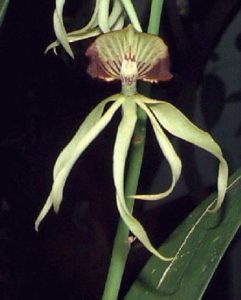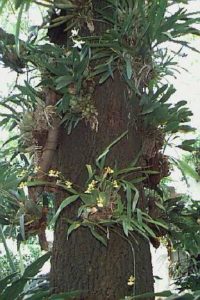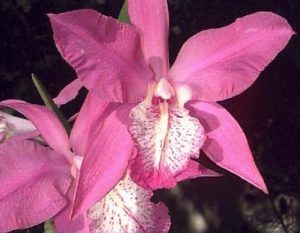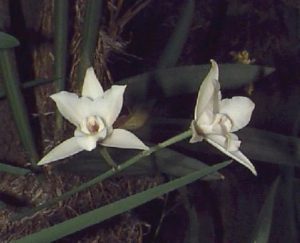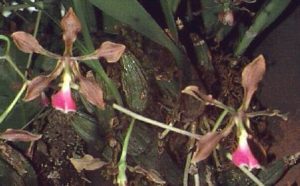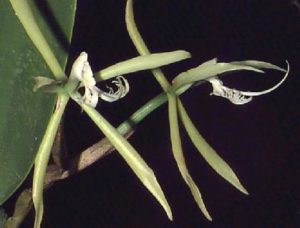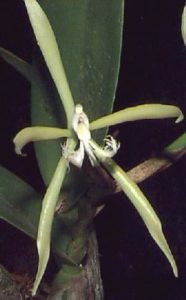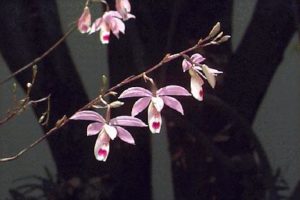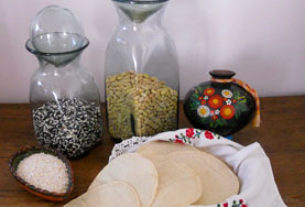Orchid. This sole word conjures up all that is beautiful, exotic, rare. An aura of fascination has always encircled this extraordinary plant family. Its cultivation is considered something esoteric and difficult. Not so. In a climate as the one we enjoy in Guadalajara and surrounding areas, to maintain a healthy and productive orchid collection is a task that can be accomplished by any lover of flowers.
What is an orchid?
This might seem an idle question. It is not. There are an estimated 30,000 orchid species in nature, making them the most extense floral plant family on Earth. There are specimens as big as a tree, and miniatures with flowers as small as a pin head. A family so vast and diverse understands more about exceptions than about rules. Nevertheless, a quality more than any other defines the orchid: the fusion of the feminine portion of the flower – pistils – with the masculine, – stamens. Orchids have three pistils and three stamens, but they differ from other flowers, which present these elements as separate units, in that orchids have them fusioned into one structure called column or gynostemium, located in the center of the labelum, that usually showy and colored lip we admire in the flower.
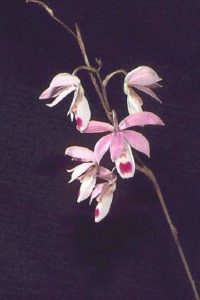
Orchids are one of the most developed of all monocotyledons. They exhibit notable specializations for pollination, as well as advanced water storage systems that contribute to their success in the fight for survival. It is one of those systems to store water, tuberoids often found in terrestrial orchid species, that gave name to the genus Orchis. Theophrastus, a botanist in ancient Greece, observing a pair of these devices in an orchid he was studying, compared them with another pair also found in nature (orchis, testicles). Another water storage system, used by epiphytic orchids, which live on trees, is the one called pseudobulbs, those protuberances found in the base of the leaves.
Classification
Classification work for the Orchidaceae family is not yet finished, of course. The Dressler system, published in 1981, lists six subfamilies, more than 725 genera and close to 25,000 species. Closely related plants, with similar characteristics, are consequently grouped, using the concepts of Tribe and Subtribe.
According to the convention used in botanic nomenclature, each orchid has a latin name, composed of two units: genus (plural, genera) and species. So, Laelia maialis refers to a unique orquid species. First name, Laelia, indicates that this plant belongs to that genus, a group well represented in Jalisco and neighboring states. The second name, maialis, distinguishes this Laelia from all others. By the way, this very pretty and spectacular species, abundant in Jalisco, Michoacán and Zacatecas, flowers in May, hence the name maialis.
Hybridization
No other family of plants has produced so many hybrids, either natural or man-induced ones. It is estimated that there are close to 100,000 hybrid varietals nowadays, and the number keeps growing, thanks to the intense hybridization activity displayed by commercial and amateur growers alike. To take pollinia from one flower and then deposit it on another, in order to obtain a new hybrid, is an easy task. The difficulty lies in the seeds inside the capsule (as the orchid fruit is called): they do not contain the nourishment other seeds carry to feed the new plant as it germinates, as beans store albumin. In nature, orchid seeds associate with a fungus that produce the sweets to allow the embryo to start its development. Only after those nutrients were synthesized in the lab has the hybridization industry undergone the explosion of growth that we witness today. Many of the Cattleya, Phalaenopsis, Cymbidium, Paphiopedilum and Vanda we admire at the Expositions or Fairs are the result of the patient labor of the successful breeder.
Where do orchids live?
Orchids grow in almost any climate and region, from the Arctic zones to the Tropics. Perhaps the only place on Earth where we cannot find them is in the bottom of the sea, although there are orchids that swim in fresh waters. It is in tropical and temperate regions where we find them more profusely, not only in numbers, but also in variety of forms and colors.
Although many orchids, especially in cool zones, live on the ground, in tropical and sub-tropical regions they grow over trees or rocks; these species are called epiphytes. A common but erroneous belief is that orchids are parasite plants that feed on the trees they live upon. Not so; they just borrow vital space and support from them. In fact, in benign climates as the one we enjoy in Guadalajara and Chapala, a very agreeable way to cultivate these beautiful plants is to fix them, direct or indirectly, to a tree trunk suitable to the purpose.
A majority of orchids live in zones where alternate periods of rain and dry climate occur. These plants need a dry period – called rest period – if they are to flower properly.
How to start an orchid collection
Growing orchids at home is easier than you imagine. To attain success, you just have to follow a set of simple rules, some of which I’ll describe now.
- Buy sensibly – Adopt plants according to the conditions of your surroundings. If you live in a tropical climate, then work with plants that can stand the heat, more than with high mountain species. As much as possible, and keeping budget considerations in mind, modify your growing conditions to suit those your plants would find in their natural habitat.
- Observe – Inspect your plants frequently. Look for symptoms of disease, plagues, or insect attack. Detect in time if your plants suffer from inadequate conditions to grow: loose leaves or leaf yellowing, lack of flowering or new shoots; general decline.
- Light – Orchids, as any plant, need light to photosintezise minerals present in the environment into sap and nutrients. Dark leaves and no flowering indicate insufficient light levels; yellow or even burned leaves point to an excess of sunlight. Different species require different conditions; find out what your new plant needs before condemning it to an inadequate environment.
- Temperature – Orquids grow in very diverse environments: from sea level to the high mountain; from the Tropics to Arctic zones. It is obvious that each species will need specific temperature ranges. In the higher regions, temperature levels between day and night may vary considerably, while at sea level the situation is more stable. We may classify orchids as warm temperature plants (minimum nocturnal temperature: 20 ºC); temperate (minimum of 13 to 18 ºC); and cool temperature species (from 10 to 13 ºC). We will have to look for plants that will adapt to the conditions of our environment. Let us remember that, to properly flower, orchids will generally need notable temperature variations between day and night. That may be accomplished inside the house by opening a window during the night.
- Water – This is the most complicated variable to control, because it depends on the behavior of many others: relative humidity, potting media, light intensity, temperature, air circulation. As we have said, many orchids need an anual resting period that, if not observed, will result in improper or no flowering at all. In general, we have to add water in quantity when the plant is in active growing, and reduce the amount after flowering. Species with sizable pseudobulbs, such as Catasetum, many Laelia and some Dendrobium, store water and are well prepared for their resting periods. Others, like Phalaenopsis, Paphiopedilum and Masdevallia, that do not show pseudobulbs, require more frequent watering. Study the natural conditions of your orchid and proceed accordingly. Watering should be augmented with greater light and temperature intensities; greater air circulation, less relative humidity and growing on open and well drained media. When watering, do it profusely; in that way you will clean accumulated salts and remnants in pots and other growing supports.
- Fertilization – Orchids, like any other living being, need food to survive. There are many formulas in the marketplace especially prepared for orchids. The three main elements to watch, nitrogen, phosphorus and potasium, are always specified in commercial labels. Different species will need different combinations; you will have to use the proper mix. Plants also require other microelements: care will have to be taken in this respect. The golden rule of fertilization is: feed lightly and frequently. Too much fertilizer in the water may burn and even kill a plant. There is a very interesting product you may find today, litonite, developed and produced exclusively in Cuba, that gives support and food at the same time for almost any type of plant, orchids included. Litonite is a zeolite, that is, a special gravel that absorbs mineral salts and then gradually releases them to plant roots via an ionic interchange. You may buy litonite in Guadalajara, in domestic quantities, through Asociación Mexicana de Orquideología, Sección Jalisco.
- Air circulation – Orchids in nature enjoy full air circulation in abundance; epiphytes in particular, accustomed to maintain their roots exposed to the open air. When these plants are grown in pots, a media should be found, sizable enough as to permit an adequate air circulation through the root system. Besides, an open environment must be secured when growing orchids at home.
- Potting – The use of pots to sustain orchids is very popular among growers. In dry climates, where relative humidity is low, it is specially useful to employ pots that retain water much more than a tree or a rock surface. There are many different media to support orchids inside the pot: osmunda or other tree fern fiber; fir bark, cork or even the jal gravel that give our state its name. Many potting media degenerate with time, so it will be necessary to renovate them regularly. Some genera, such as Gongora, produce flowers that bend to the ground; we will have to put them on a branch of our orchid tree, or in a basket with a hollow bottom to allow the passing of the flowers. As it was mentioned, a very adequate way to grow epiphytes is to fix them over a twig or discarded branch that can be in turn attached to a generous tree in our patio.
Clubs and Associations
The beauty, complexity and attractiveness of the Orchidaceae family has many people captivated. For this reason, you can find associations and fan clubs for these extraordinary plants in almost any part of the world. In Guadalajara, Asociación Mexicana de Orquideología, Sección Jalisco, meets regularly on Parque Agua Azul premises. Bulletins are published; expeditions are organized. The systematic destruction, in many regions of the world, of forests and wild spaces, has reduced in considerable proportions the habitat of many plants, orchids among them. In consequence, a common vital objective to defend among organized groups is the preservation of the species that Our God put in this world for the benefit of all.
Updated February, 2018

